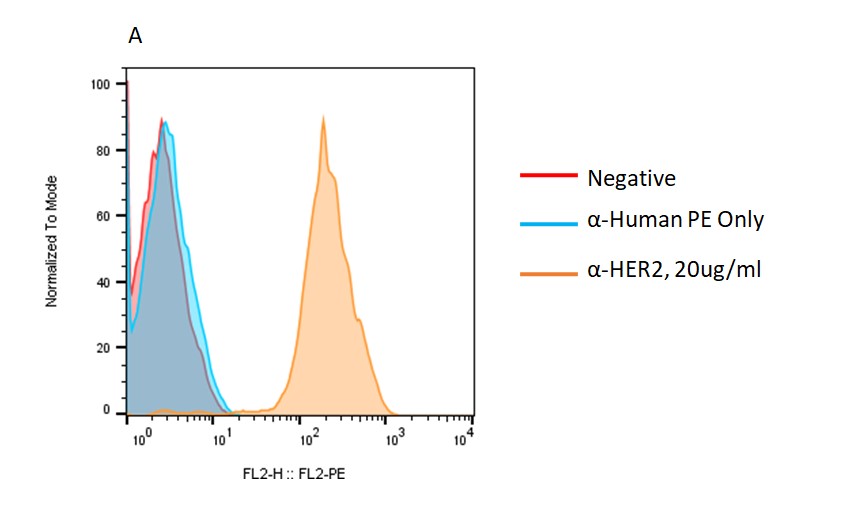
| Catalog Number | Product | Size | Price | |
|---|---|---|---|---|
| A1019-100 | Anti-human HER2 | 100µg | $185 | Order |
| A1019-200 | Anti-human HER2 | 200µg | $325 | Order |
| Catalog Number | A1019 |
|---|---|
| Product Name | Anti-human HER2 |
| Source | Recombinant anti-human HER2 mAb produced in HEK293 cells |
| Clone | Trastuzumab |
| Species Reactivity | Human |
| Isotype | Human IgG1 |
| Purity | >95% |
| Formulation | 50mM Na Acetate, pH5.2. Sterile |
| Stability & Storage | 1 month at 4oC; 12 months at <-20oC; Avoid repeated freeze-thaw |
| Protein Aggregation | Not obvious on SDS-PAGE |
| Application | Flow cytometry, ELISA, cell-based assay |
| Product Datasheet: | Download PDF |
Detection of HER2 expression on human colorectal adenocarcinoma cell line HCT-15 by flow cytometry. Anti-human HER2 antibody (Cat. #A1019) was incubated with human HCT-15 cells, followed by staining with PE-anti-mouse IgG.

Her-2, also called Neu and ErbB2 (human epidermal growth factor receptor 2), is a type I membrane protein that is a member of the ErbB family of receptor tyrosine kinases. ErbB family members include EGFR, ErbB2 (Neu, Her-2), ErbB3 (Her-3), and ErbB4 (Her-4) and they serve as receptors for the epidermal growth factor (EGF) family of growth factors. Her-2 is widely expressed in epithelial cells and is over-expressed on a large population of breast cancer cells. Comparing to the other members of the ErbB family, Her-2 is unique in that it has no known ligands and it can heterodimerize with the other members of the ErbB family to form higher affinity signaling complexes. Mature human Her-2 consists of 1233 amino acids (aa) with a 630 aa extracellular domain, a 23 aa transmembrane region, and a 580 aa cytoplasmic domain. Her-2 may play a variety of roles in development and regulation of cell growth and differentiation (1-6).
Ullrich, A. et al. (1984) Nature. 309:418.
Graus-Porta, D. et al. (1997) EMBO J. 16:1647.
Singh, A.B. and R.C. Harris (2005) Cell. Signal. 17:1183.
Burgess, A.W. et al. (2003) Mol. Cell. 12:541.
Roskoski Jr., R. (2004) Biochem. Biophys. Res. Commun. 319:1.
Lemmon, M.A. et al. (1997) EMBO J. 16:281.